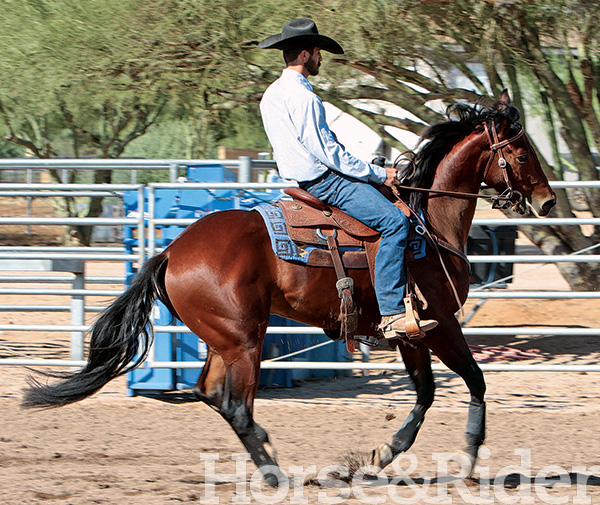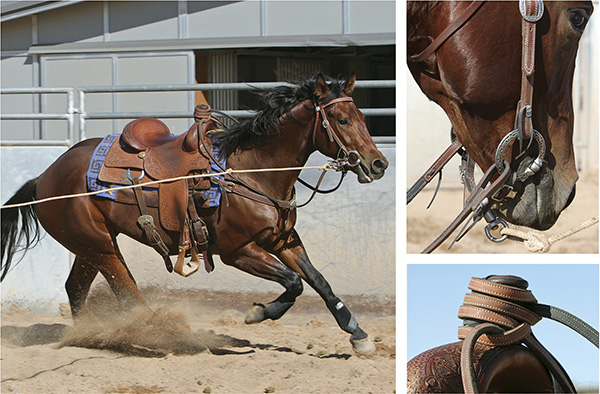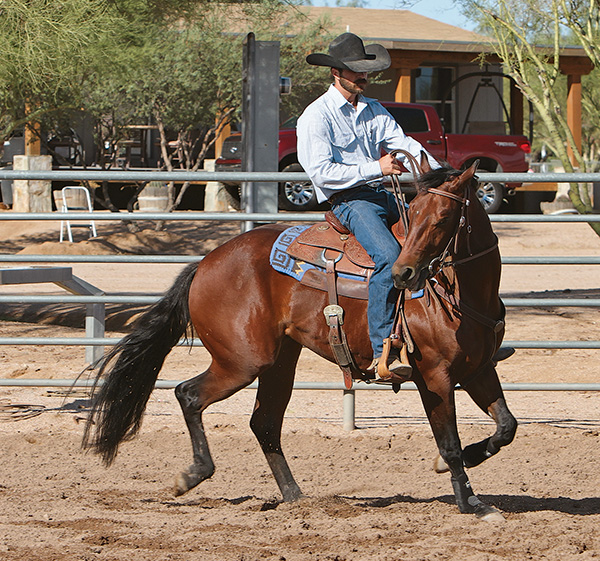Q: Almost every time I ask my horse to pick up a lope in either direction, he bucks. Sometimes it’s just a small lurch forward, and other times he really gets a good buck in. I’m an experienced rider, and I feel I can work through this with him. How would you handle the problem if he were your horse?
[FOR MORE WITH BRAD: Horse&Rider OnDemand]

JAYCIE SWANSON, Wisconsin
A: If you’re an experienced rider, you shouldn’t have problems working through this issue with your horse. Whether he bucks into the lope or charges, the training solutions are similar. Before you do anything else, be sure to check with your veterinarian to rule out physical problems. Soreness can cause both of these behaviors. Also check your tack. A poorly fitting saddle could also be to blame.
I’ll offer you three ways to address your horse’s behavior so you can get back to enjoyable riding, and he can learn that bucking and rushing aren’t acceptable answers when asked to lope.
[READ ABOUT: Basic Leg Positions with Brad Barkemeyer]
Solution #1: Part Ways?
I’ll be blunt: Bucking is a dangerous behavior. If you’re not an experienced rider, sticking with this horse could crush your confidence and lead to injury. If you don’t have the skills and confidence to work through the problem, it might be best to part ways with this horse and find one that better suits your abilities and skill level. This could mean selling the horse to a more experienced rider or sending the horse out to a trainer who can work past the horse’s urge to buck and lurch when asked to lope.
There’s no shame in admitting when a horse is too much for your riding level. In fact, it usually ends up with both of you in better situations. You mention that you’re an experienced rider, so the rest of my advice applies to keeping the horse and riding him through his issues.
Solution #2: Groundwork
Working on this in the round pen, with you on the ground, is a safe way to start. Saddle and bridle your horse, so it’s as similar to riding as possible. Use a snaffle bit for mild contact with your horse’s mouth.

Tie the reins around the horn (see photo) with slack in the reins similar to what you’d have when riding, or slightly more slack. Don’t ever tie the reins without any slack; your horse needs room to move his head and neck and feel release when he’s traveling forward and straight. But also don’t leave so much slack that he could entangle his feet and legs. Never leave your horse unattended with the reins tied to the saddle horn.
Snap a lariat or longe line to the snaffle’s curb strap. The snap should easily rotate to allow quick changes in direction at your cue. Work through all transitions in both directions. If your horse lurches into a lope or bucks when you cue for it, change directions immediately, and ask him to lope off again. Repeat the direction change if he lunges or bucks into the lope. When he picks up a lope in the desired manner, let him lope a few strides, then gradually decelerate to a stop.
You can also work on accustoming your horse to your leg cues from the ground, if that’s what’s triggering his response to a lope cue. Bump his sides with the stirrups, and encourage him to yield to the pressure. When you do this, be sure to stay far enough forward that you’re out of danger from being kicked or run over if he bucks or lunges forward.
Solution #3: Pull Him Around
Begin by riding two-handed, sitting in an athletic riding position—your seat deep in the saddle, legs under your hips, and hands prepared to move. This way, you’re ready to either lope off without any problem or pull your horse around if he bucks or rushes forward.
[READ ABOUT: Keep Your Horse Moving with Brad Barkemeyer]
Cue for a lope from a walk or standstill. Give your horse a chance to lope off—don’t anticipate that he’ll jump forward, or chances are he will. Riding in a fearful position, ready to hang on if he tries to leave you, makes your horse anxious. He’ll begin to associate your fearful position with his lurching and bucking.
If your horse lopes off smoothly, travel a few strides, then quietly stop him and offer praise. Repeat the cue from a standstill, walk, and trot to build your confidence and reinforce his response to your cue.
If he rushes forward or bucks, immediately pull his head to the left or right by bringing that rein hand back to your hip. Use a steady pull, not a jerk, to circle your horse down to a stop. Gather your wits, then ask again for a lope. Repeat the request until he departs without incident. Lope a few strides, then stop and praise him.

This requires patience, persistence, and repetition, but you can overcome this behavior so you and your horse can enjoy your rides more.
Brad Barkemeyer, Scottsdale, Arizona, grew up on a ranch in Montana, which gave him an appreciation for versatile horses. He now trains open and amateur horses and coaches riders to success in AQHA, NRCHA, and NCHA competiton.






